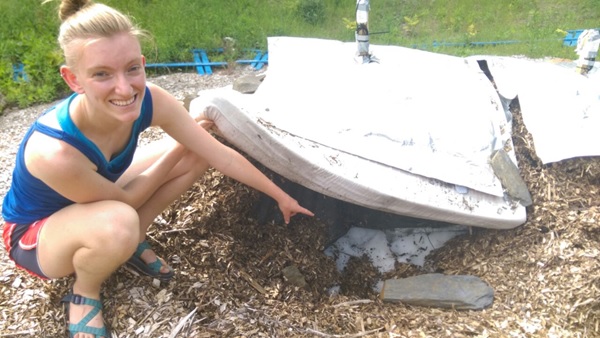Snow Storage: Final 2018 Data
We’re excited to be working with UVM geology on a snow storage test. UVM master's student Hannah Weiss brings us up to speed on the state of the snowpack.
You might remember back in April, as the last snow was melting, Keith Woodward was piling up snow under the solar panels and down in Wilbur’s old pond site and covering it with wood chips? Or perhaps you remember when some of snow made a cameo appearance in July for sledding and trick skiing at the Craftsbury block party? Maybe you have seen us out surveying the piles over the summer? Well, it’s September and time for an update on our snow storage project: it worked! We still have a little snow left after one of the hottest summers on record.
September 9th, a sunny, cool fall afternoon, was our final pile surveying day the summer 2018 season. We arrived to find two piles of mostly wood chips. The piles had become lumpy, and we weren’t sure whether there even was snow beneath any of the chips. On the upper pile (CHIP pile), there were cracks within the wood chips on some of the larger lumps, which caused us to wonder why they formed. Was it because the steepness of the slope caused slumping and cracking? Surprisingly, as we dug deeper into the wood chips, they became cooler and wet, though it had not rained it weeks.
Both the upper (CHIP) and lower (POND) piles were small and, after processing the LiDAR scans, we found only maybe 10 cubic meters of snow left in them. They each started with about 200 cubic meters. Over the summer, we also tried several different combinations of insulation – hard foam, open-cell foam, a reflective blanket, and a thicker (30+cm) layer of woodchips. We let these smaller experiments run for a week or two and tracked temperatures within the insulation layers and at the interface of snow and the insulation material.
After digesting all the data, we found that the upper pile, after snow was removed for the July 4th celebration, melted more slowly than the lower pile. The thickness of wood chips is key and likely with less snow but the same amount of wood chips, the upper pile was better insulated.
Now, as we look ahead to next summer, we know better which combination of insulation will keep the most snow. Our data show that a reflective surface covering a thick layer of wet wood chips, and underlain by an insulating concrete blanket are the most effective triad. Next summer, the piles will be much larger, and we hope to have enough snow not only to support summer sledding and perhaps a ski race or two but have plenty of snow left to spread on a couple kilometers of trail in November to kick off ski season, no matter the weather.
Read all the posts of the series here. To learn about the research, see photographs over time, and more, visit UVM online.





